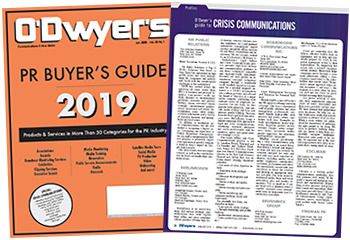 Gil Bashe (L) and Michael Heinley co-authored this article. |
The state of the art of crisis communications isn’t static; it’s quickly evolving, morphing as rapidly as media itself. We see it most clearly in the sudden appearance of the vigilante questioner of your integrity and intent, who has many easy to access platforms from which to choose to launch questions, inquiries or attacks against you.
It’s an increasingly difficult landscape. Individuals can raise questions that encourage others to join the chorus in doubting your integrity and share those questions to an increasingly wider circle through the ripple effect of social media. In addition, crisis management is exacerbated by the fluid meaning of “truth” itself. What is the truth? In the current era of undermining careful, methodical reporting through innuendo, lies and flat out attacks against the integrity of editorial, does objective truth still exist?
|
|
Consider this likely scenario: while you evaluate the nature and extent of your detractor’s claims to best formulate your response plan, you come up against issues driven by virality. New questioners — enlisted through passionate social media posts — may or may not have familiarity with your company or a clear idea of the issues they’re reacting to and amplify the magnitude of your problem even before you fully understand your problem.
You used to have a 24-hour news cycle to get this right. In the ’90s and earlier, we still had news cycles; broadcast was the fastest media and you had a day to address stories. With print media, you had an even larger window of time to investigate, analyze and engage. Certainly, those outlets remain important and can sway and influence audiences, but digital media sped the news cycle up to minutes, not days. Now, we’ve left that second age of news cycles and if you’re going to effectively manage crisis, you need to recognize that shift and deal with what’s upon us.
It’s the age of Twitter and blogging. Less than a decade ago, the digital news cycle was driven by the news and it included opinion from thought leaders and advocacy groups — not that different from the age of print and broadcast. Fact-checking and accuracy was the gold standard for solid reporting. Now, while there are certainly traditional media outlets and respected digital outlets in the game, social — corroborated or not — drives the news. Trends must be aggregated, analyzed and acted upon in seconds.
The quotable, memorable zinger puts a pundit on the same level as a creditable reporter. A lone Tweet can — and does — start a firestorm. Perspective is becoming more dominant than news; it’s being treated as news and doesn’t require fact checking to be widely accepted as fact. Many news networks report perspective every day. Their producers realize it gets more eyeballs than actual, reputable news.
As the standard for fact-based rigor loosens across all forms of media, editors have moved toward including the mud-stirrers in their stories. Print media will fact check and hold until ready, but because the news cycle is so splintered, even the New York Times will go with the facts and perspective, though the Times and others clearly label it as such.
This shift in news media leads to them having a more “authentic” voice and perspective. Authenticity comes with a price; many media outlets now have a more compelling voice because they no longer rely on facts for every part of a piece.
Companies need to watch that new norm. They also need to ask themselves in every crisis or potential crisis: Do I pay attention to national perspective? Do powerful pundits and their non-factual perspective need to be taken into account? How do I support factual reporting when it’s easy for editors to become overwhelmed by the roiling seas of social conversation?
In recent crises involving trusted and long-established brands, we’ve seen reputations and customer relationships put on the line. We used to build a crisis plan with a strong position at the center, work with media and thought leaders to convey our point-of-view. However, with citizen media (e.g., Twitter, Blogposts and comments posted to mainstream media) so accessible, crisis management has become infinitely more complex and personal.
Think about the moment when you’re bumped from a flight and tweet-out your dissatisfaction. Almost immediately, the airline’s social media staff will engage and take the conversation offline. The personal nature of social media means that we need to be more responsive, more attentive, to maintain reputation and relationship — especially in issues management.
You need pattern recognition skills. Social media pundits may cause a reputable company to stand down. Are you prepared to stand strong in the social media swirl? To have the staying power to be kicked in the shins for a day or so until an issue goes away? What will be the impact on your lasting digital footprint or stock valuation — just a blip, or hobbling damage that will hurt you for weeks, months and years to come?
Those are the different realities of crisis communications now, and you need to task knowledgeable experts, able to monitor and engage using the clock and media channels that appeal to Boomers and Millennials alike. That same personal skill that serves customer service professionals well must become part of the crisis management process. And crisis response needs to be a much more thoroughly thought out process. When you look at the companies undergoing crisis that are using only mass media, you’ll understand that social and digital now requires a shift in your approach. If you’re not working an issue or crisis from the perspective of an individual impacted — taking it personally — your detractors will.
***
Gil Bashe is Managing Partner, Global Health at Finn Partners. Michael Heinley is Partner and Deputy NY Health lead at Finn Partners.



 There’s a fine line between newsjacking and taking advantage, aka ambulance chasing. Our job as PR professionals is to tread it carefully.
There’s a fine line between newsjacking and taking advantage, aka ambulance chasing. Our job as PR professionals is to tread it carefully. PR firms need to be mindful of ways their work product may be protected by the attorney-client privilege whenever working with a client’s internal legal team or its external legal counsel.
PR firms need to be mindful of ways their work product may be protected by the attorney-client privilege whenever working with a client’s internal legal team or its external legal counsel. Manuel Rocha, former US ambassador and intenational business advisor to LLYC, plans to plead guilty to charges that he was a secret agent for Cuba.
Manuel Rocha, former US ambassador and intenational business advisor to LLYC, plans to plead guilty to charges that he was a secret agent for Cuba. CEO mentoring is an often-overlooked aspect of why CEOs are able to make good decisions, and sometimes make bad ones—all of which intersects with the role and duties of a board.
CEO mentoring is an often-overlooked aspect of why CEOs are able to make good decisions, and sometimes make bad ones—all of which intersects with the role and duties of a board.  How organizations can anticipate, prepare and respond to crises in an increasingly complex world where a convergent landscape of global challenges, threats and risks seem to arrive at an unrelenting pace.
How organizations can anticipate, prepare and respond to crises in an increasingly complex world where a convergent landscape of global challenges, threats and risks seem to arrive at an unrelenting pace.


 Have a comment? Send it to
Have a comment? Send it to 
No comments have been submitted for this story yet.